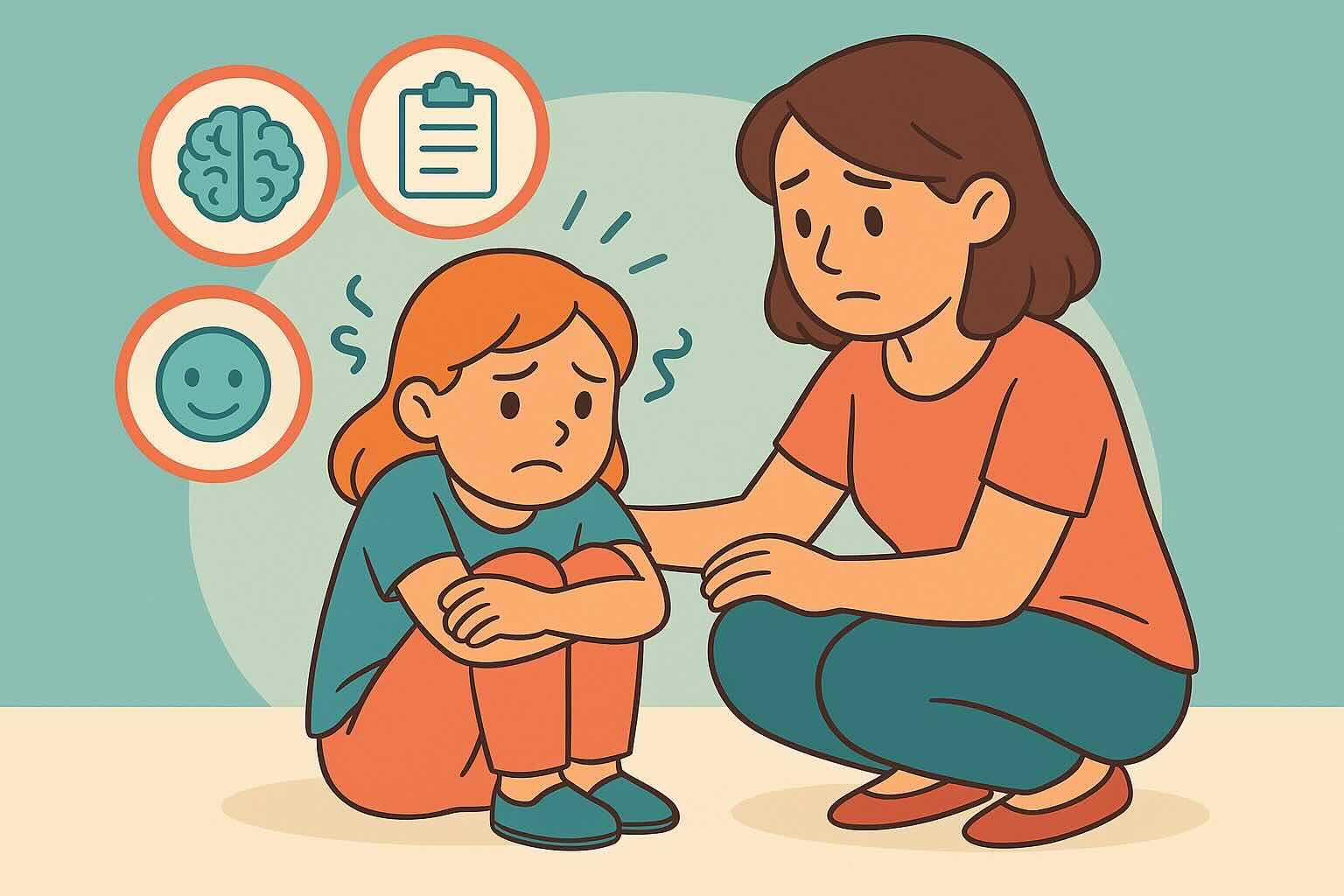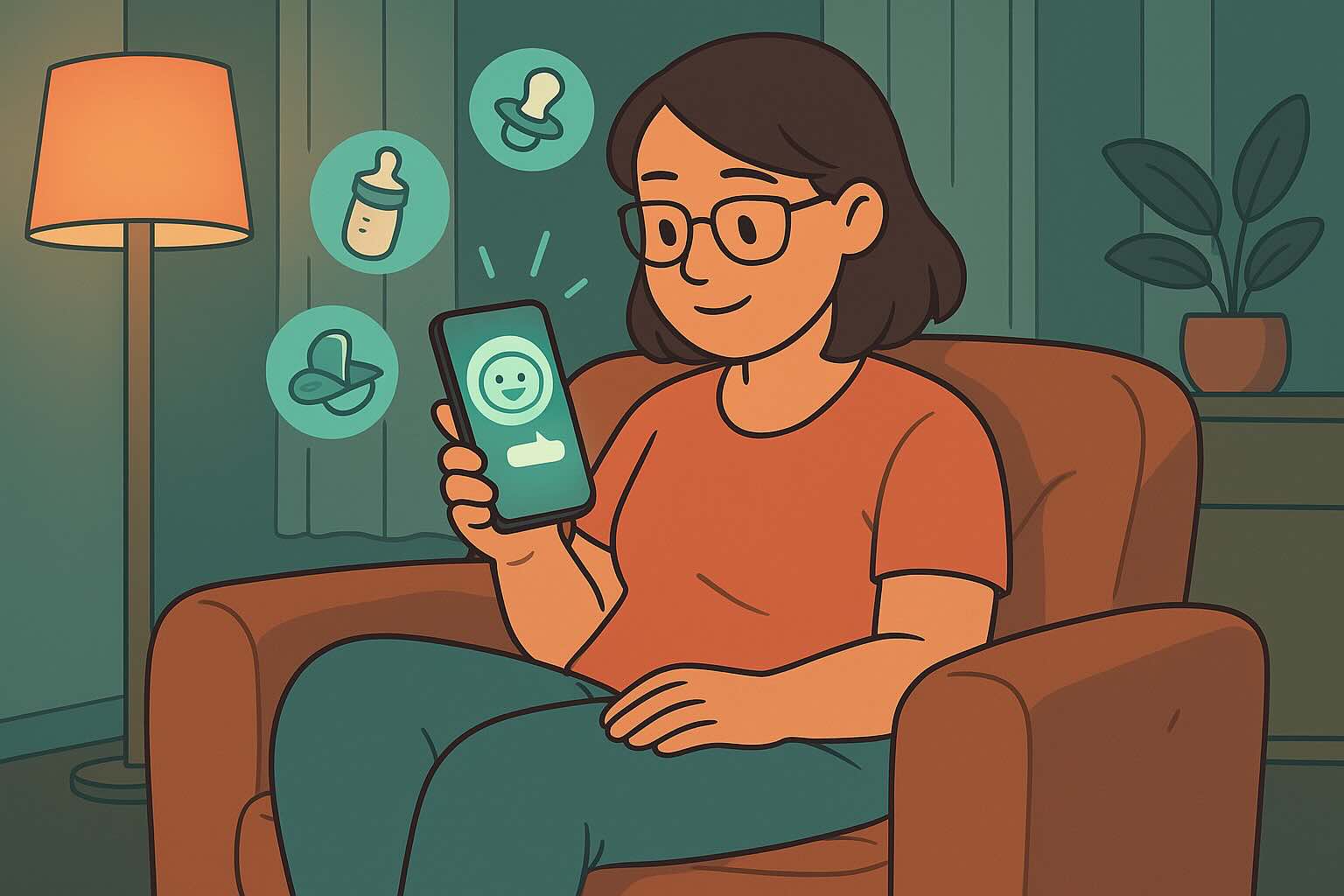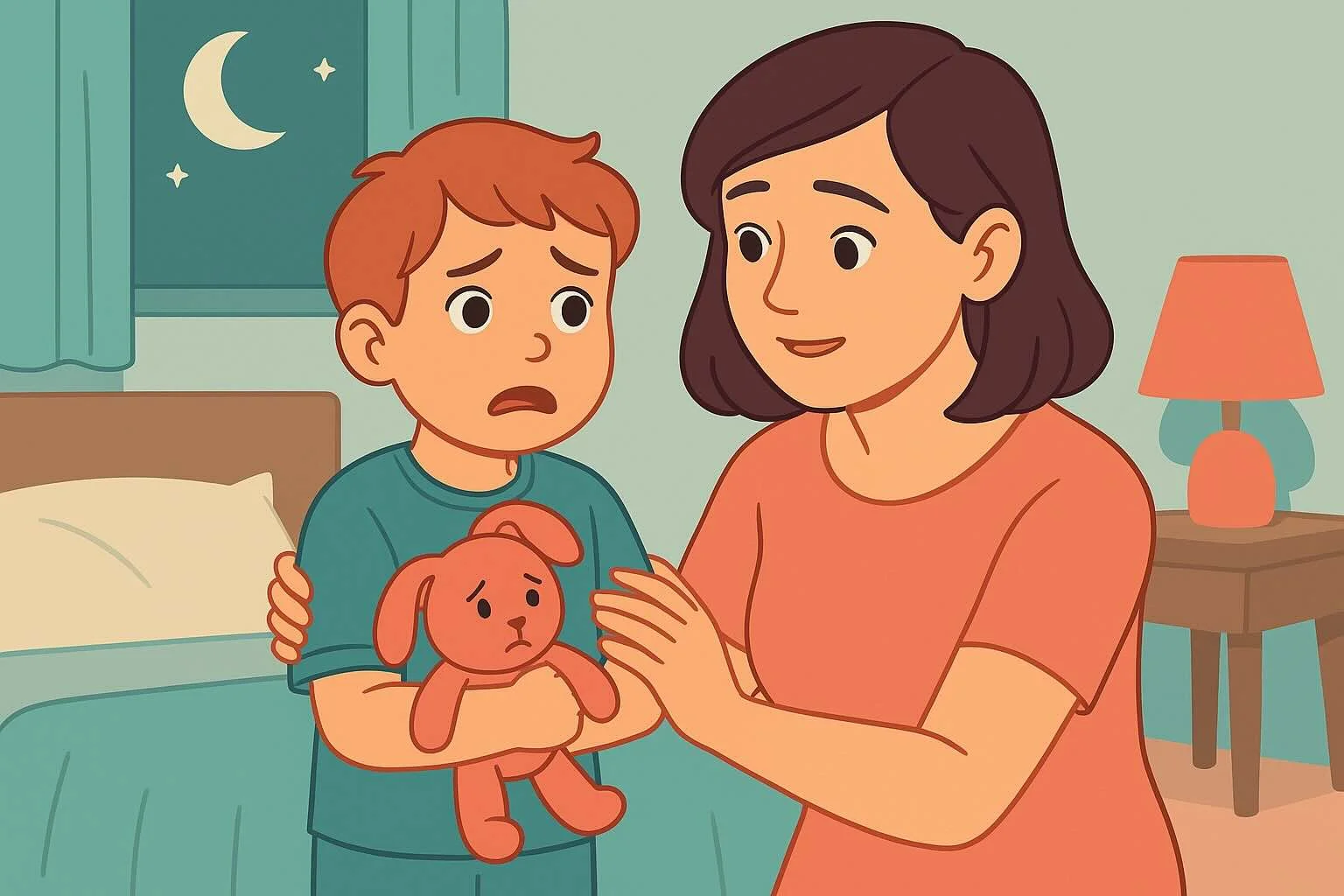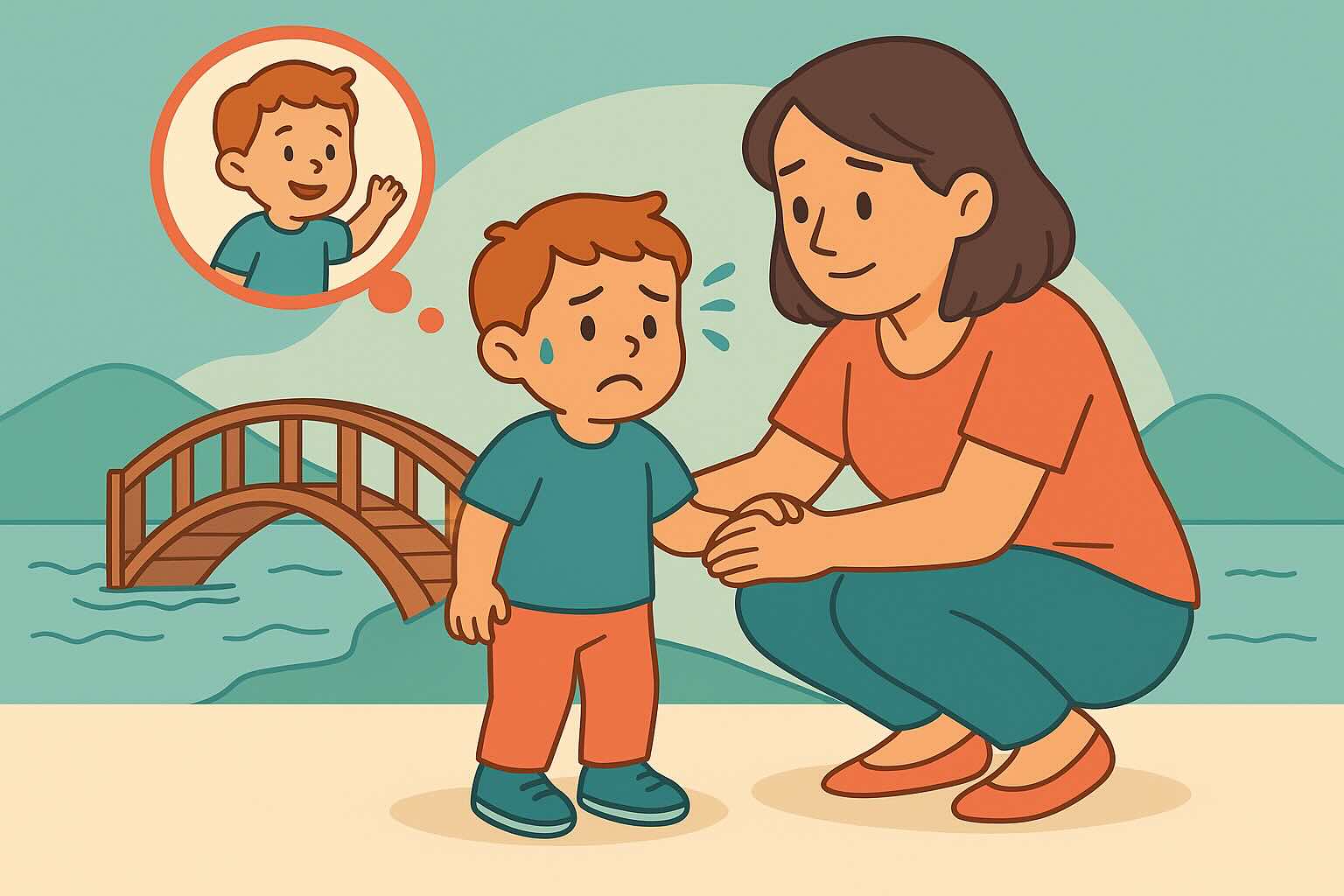Childhood Anxiety in Ages 5-7: 11 Confidence-Building Tools


Your 6-year-old suddenly starts having "stomachaches" every morning before school. Your 5-year-old asks "What if...?" questions all day long. Your 7-year-old has started biting their nails until they bleed and asking to go to the bathroom constantly. These behaviors often signal childhood anxiety—a condition that affects 15-20% of school-age children but frequently goes unrecognized because it doesn't look like adult anxiety.
This comprehensive guide provides evidence-based strategies from child development research, tested by real parents. No more confusion about whether to reassure or ignore—just practical tools with realistic expectations about anxiety management.
For related challenges, also check out our nighttime fears guide and fear of new experiences. You may also find our guides on room independence and trauma processing helpful for anxiety-related fears. If anxiety affects sleep, see our healthy sleep habits guide and bedtime fears guide for specific nighttime anxiety strategies. For managing challenging behaviors during anxious periods, explore our emotional safety approaches. Children with anxious temperaments may benefit from our sensitive child guide for understanding their cautious nature.
What You'll Learn in This Guide
- The Real Science - Why ages 5-7 are uniquely vulnerable to anxiety development
- Honest Statistics - Realistic data about childhood anxiety patterns and recovery rates
- The "Sit With the Feeling" Method - Exactly how to validate anxiety without making it worse
- Physical Symptoms Management - When "stomachaches" are really anxiety in disguise
- The What-If Question Strategy - How to respond to anxious thoughts effectively
- Building Internal Coping Skills - Tools children can use independently
- When Professional Help Is Needed - Red flags indicating anxiety disorders requiring treatment
Estimated reading time: 11 minutes
Why Ages 5-7 Are Vulnerable to Anxiety: The Brain Science Every Parent Should Know
Your Child's Brain: Why This Age Creates Anxiety
Ages 5-7 represent a unique vulnerability period for anxiety development. Your child's brain has developed enough to imagine future scenarios and understand potential dangers, but their prefrontal cortex—responsible for realistic risk assessment and emotional regulation—is still years away from maturity.
This means your child literally cannot evaluate the realistic likelihood of their worries. When they ask "What if there's a fire at school?" their brain experiences this as a genuine, immediate threat rather than an unlikely possibility they can prepare for calmly.
Important note: While this brain development model helps explain anxiety patterns, modern neuroscience recognizes that anxiety involves complex interactions between multiple brain systems. The key point remains: children need specific support to develop anxiety management skills.
When Normal Worry Becomes Problematic Anxiety (Ages 5-7)
During this developmental period, several factors converge to create anxiety vulnerability:
- Future thinking development: Can imagine negative scenarios but can't assess probability realistically
- Social awareness increase: Growing awareness of judgment from peers and adults
- Academic pressure introduction: First exposure to performance evaluation and comparison
- Independence expectations: Pressure for self-reliance while still needing emotional support
- Media exposure impact: Even brief scary content can fuel persistent worry
For children whose anxiety manifests primarily around bedtime and sleep, our bedtime fears and anxiety guide provides specialized strategies for nighttime worries, while our nighttime fears complete guide addresses ongoing sleep-related anxiety patterns.
Normal Worry vs. When to Worry About Your Child
Normal childhood worries:
- Temporary concerns about specific events (tests, new activities)
- Worry that doesn't significantly interfere with daily functioning
- Anxiety that responds to comfort and reassurance
- Fears that improve with time and positive experiences
Research-based childhood anxiety statistics:
- Prevalence: 15-20% of children ages 5-7 experience significant anxiety
- Peak onset: Ages 5-6 during school transition and cognitive development leaps
- Gender patterns: Slightly higher rates in girls, though boys are often underdiagnosed
- Recovery rates: 80-90% of children improve significantly with proper support
Concerning anxiety patterns that warrant professional consultation:
- Persistent duration (symptoms present for 6+ months without significant improvement)
- Functional impairment (significantly interferes with school, friendships, or family life)
- Severe physical symptoms (frequent panic attacks, persistent physical complaints)
- Avoidance patterns (refusing school, avoiding social activities, limiting normal experiences)
- Family impact (anxiety symptoms significantly disrupt family functioning)
- Self-harm thoughts (any expression of wanting to hurt themselves or not wanting to be alive)
How to Support Your Anxious Child: "Sit With the Feeling" Method That Works
This evidence-based approach from emotional development research helps children learn that anxiety is uncomfortable but not dangerous. The method works by building emotional tolerance and internal coping skills rather than external reassurance dependence.
Step 1: Pause Before Responding (Resist the Fix-It Urge)
Your first priority is managing your own anxiety about your child's distress. When children express worry, parents' natural instinct is to immediately reassure or solve the problem, but this often increases rather than decreases anxiety.
What to say:
- "I can see you're feeling worried about tomorrow."
- "That sounds like a nervous feeling in your body."
- "You're having some big feelings about this."
What NOT to say:
- "Don't worry about that!"
- "You'll be fine, there's nothing to worry about."
- "Just think about something happy instead."
Step 2: Validate the Feeling (Not the Thought)
Research in emotional development shows that validation is the most powerful tool for helping children develop emotional regulation skills. You're acknowledging their emotional experience without agreeing that their worry is realistic.
How to implement:
- "It makes sense that you'd feel worried about starting something new."
- "Lots of kids feel nervous about tests."
- "Your body is telling you that this feels important to you."
- "Worry is something everyone feels sometimes."
Step 3: Sit With the Feeling Without Rushing to Solutions
This is the crucial step that most parents skip. Instead of immediately jumping to reassurance or problem-solving, you stay present with their anxiety for 30-60 seconds.
During this phase:
- Stay physically close and emotionally calm
- Don't try to talk them out of the feeling
- Let them experience your steady, non-anxious presence
- Resist the urge to immediately fix or explain away their worry
Sitting scripts:
- "Yes, you're feeling worried. I'm right here with you."
- "That's a big feeling. We can handle big feelings together."
- "I can see this feels scary to you right now."
Step 4: Explore When They're Ready (Don't Rush)
Only after you've validated and sat with the feeling should you begin exploring the worry or building problem-solving skills.
Exploration questions:
- "Tell me more about what you're worried might happen."
- "How often do you feel this way?"
- "What does the worry feel like in your body?"
Step 5: Build Internal Problem-Solving Skills
Once your child feels heard and supported, you can help them develop their own coping abilities rather than relying on external reassurance.
Problem-solving questions:
- "What do you think you could do if that happened?"
- "Have you ever felt worried about something before that turned out okay?"
- "What helps you feel braver when you're nervous?"
7 Proven Ways to Manage Childhood Anxiety Before It Becomes Overwhelming
The CALM Method: Check These 4 Foundation Elements
Before anxiety becomes a persistent problem, ensure these foundation elements are in place:
- Connection: Child feels emotionally safe and supported
- Awareness: Understanding of what anxiety feels like and that it's normal
- Language: Words to describe different types of worried feelings
- Management tools: Age-appropriate coping strategies they can use independently
Research support: Studies consistently show that children with these foundational skills develop anxiety resilience more effectively than those without early emotional education. Understanding how your own parenting brain adapts can help you provide the emotional support your anxious child needs.
Environmental Setup for Anxiety Management
Create predictability and control:
- Consistent daily routines that reduce uncertainty
- Advance warning about schedule changes or new activities
- Age-appropriate choices that give child some control
- Calm-down spaces available when anxiety feels overwhelming
Reduce anxiety triggers:
- Limit exposure to frightening media content (news, scary movies)
- Minimize overscheduling and performance pressure
- Address family stress that children absorb
- Create quiet, unstructured time for emotional processing
Proactive Anxiety Skill Building
During calm moments:
- Read books about characters who manage worry and anxiety
- Practice deep breathing and relaxation techniques
- Discuss family stories of overcoming challenges and fears
- Role-play handling anxiety-provoking situations
Teach age-appropriate anxiety coping strategies:
- "Stop, breathe, think" technique for worried thoughts
- Progressive muscle relaxation for physical tension
- Positive self-talk phrases ("I can handle this," "This feeling will pass")
- Help-seeking skills (knowing when and how to ask for support)
Age-Specific Anxiety Management Strategies
5-6 Years: The "Foundation Building" Phase
At this age, anxiety management focuses on building emotional vocabulary, basic coping skills, and environmental support.
Strategies that work:
- Simple emotion identification and naming
- Concrete coping tools (breathing exercises, comfort objects)
- Heavy reliance on adult support and reassurance
- Structured, predictable environments
- Physical comfort and presence during anxious moments
Common anxiety expressions at this age:
- Physical symptoms (stomachaches, headaches, fatigue)
- Clinginess and separation difficulties
- Sleep problems and bedtime fears (see our bedtime fears guide for specific strategies)
- Regression in previously mastered skills
- Frequent requests for reassurance
6-7 Years: The "Skill Development" Phase
Your child can understand more complex explanations and begin developing independent anxiety management abilities.
Strategies that work:
- Teaching thought awareness ("worried thoughts vs. helpful thoughts")
- Problem-solving for "what if" scenarios
- Building self-advocacy skills (asking for help when needed)
- Gradual independence in anxiety management
- Understanding anxiety as a normal emotion that everyone experiences
Common anxiety expressions at this age:
- Detailed "what if" questions and catastrophic thinking
- Social anxiety about peer judgment and friendships
- Academic worries about performance and mistakes
- Physical complaints that correlate with stressful events
- Avoidance of challenging or new activities
7+ Years: The "Independence Building" Phase
Your child should be developing genuine competence in anxiety management with decreasing need for constant adult support.
Strategies that work:
- Complex cognitive skills (reality testing, evidence evaluation)
- Independent use of coping strategies
- Teaching others about anxiety management
- Taking on leadership roles in anxiety-provoking situations
- Understanding anxiety as information rather than danger
Common anxiety expressions at this age:
- Philosophical worries about fairness, death, global problems
- Performance anxiety about academic and social success
- Future-focused worries about growing up and responsibilities
- Physical symptoms that they can connect to emotional states
- Desire to help other children who struggle with anxiety
Realistic Expectations About Anxiety Management Success
What Research Actually Shows
Anxiety management expectations:
- Most families see some improvement within 3-6 weeks of consistent implementation
- Significant reduction (50%+ decrease in episodes) occurs for 80-90% of children
- Complete elimination of anxiety is unrealistic and not developmentally appropriate
- Individual variation is enormous—some children respond quickly, others need months
Important caveats:
- Highly sensitive children may need 8-12 weeks to show significant improvement
- Success often means better coping rather than absence of anxious feelings
- Consistency across home and school is crucial for effectiveness
- Major life changes can temporarily increase anxiety even with good management
When Anxiety Management Doesn't Work as Expected
After 6-8 weeks of consistent implementation:
- Consider whether underlying anxiety disorders require professional treatment
- Evaluate family stress levels and modeling of anxiety management
- Assess school environment for anxiety triggers or support needs
- Rule out medical causes for physical symptoms
- Remember that some children need specialized therapy rather than family support alone
When to Seek Professional Help
Red Flags That Warrant Professional Consultation
- Persistent duration (anxiety symptoms present for 6+ months without significant improvement)
- Severe functional impairment (cannot attend school, participate in normal activities)
- Panic attacks or severe physical symptoms (difficulty breathing, chest pain, dizziness)
- Avoidance patterns that limit normal childhood experiences
- Self-harm behaviors or thoughts of wanting to die
- Family functioning significantly impacted for 3+ months
- Multiple anxiety disorders or very early onset (before age 4)
- Anxiety accompanied by depression, eating problems, or other mental health concerns
Types of Professional Support Available
Child psychologists provide comprehensive assessment and evidence-based treatments like Cognitive Behavioral Therapy (CBT) School counselors offer immediate support and classroom accommodations Pediatricians can rule out medical causes and provide referrals to mental health specialists Psychiatrists may be needed if medication is being considered as part of treatment Family therapists help when anxiety affects family relationships and functioning
How to Find Qualified Help
- Start with your pediatrician for mental health referrals
- Contact your insurance company for covered providers specializing in childhood anxiety
- Look for therapists with specific training in evidence-based treatments (CBT, play therapy)
- Ask about their approach to childhood anxiety to ensure it matches your family values
- Consider university training clinics that offer evidence-based treatments
Real-Life Success Stories
Sarah's Story: The Morning Stomachache Solution
"My 6-year-old Emma had 'stomachaches' every school morning for three months. The pediatrician found nothing wrong. When I learned about anxiety manifesting physically, everything clicked. Instead of just treating the stomachache, I started asking what her heart was worried about. Turns out she was anxious about who she'd sit with at lunch. We practiced conversation starters, arranged a few lunch dates with classmates, and within two weeks the stomachaches disappeared. Now when her stomach hurts, she tells me 'My tummy is worried about something' and we talk through it."
Mike's Story: The What-If Question Breakthrough
"My 5-year-old Lucas asked 'what if' questions constantly—what if there's a fire drill, what if I miss the bus, what if my teacher is absent. I was exhausted from trying to reassure him all day. Learning the problem-solving approach changed everything. Instead of answering every worry, I started asking him 'What do you think you could do if that happened?' At first he said 'I don't know,' but gradually he started coming up with his own solutions. The questions didn't stop immediately, but now he often answers them himself before I need to step in."
Jessica's Story: The School Refusal Recovery
"My 7-year-old developed severe school anxiety after a substitute teacher yelled at her class. She started having panic attacks every morning and refusing to go to school. We worked with a child therapist who taught us about 'sitting with the feeling' instead of trying to convince her school was safe. We also practiced anxiety management skills at home during calm times. It took two months of consistent support, but she went from refusing to leave the house to volunteering to help in the school office. The key was validating her fears while building her confidence gradually."
Your Realistic 8-Week Anxiety Management Plan
Weeks 1-2: Recognition and Foundation Building
- Observe anxiety patterns without trying to change them immediately
- Practice "sitting with feelings" instead of rushing to fix or reassure
- Build emotional vocabulary for different types of worried feelings
- Reduce environmental stressors and anxiety triggers
Weeks 3-4: Skill Building and Validation
- Teach basic coping strategies during calm times (breathing, self-talk)
- Continue validation approach while beginning to explore worries
- Address physical symptoms by connecting them to emotional experiences
- Create predictable routines that reduce daily uncertainty
Weeks 5-6: Problem-Solving and Independence
- Begin helping child generate their own solutions to "what if" scenarios
- Practice anxiety management skills during mildly challenging situations
- Encourage self-advocacy (asking for help when needed)
- Collaborate with school on anxiety support strategies
Weeks 7-8: Integration and Confidence Building
- Support child in using anxiety management skills more independently
- Celebrate growth in anxiety tolerance and coping abilities
- Plan for handling setbacks during stressful periods
- Evaluate whether additional professional support is needed
Ongoing: Long-term Maintenance and Growth
- Continue regular check-ins about anxious feelings and coping
- Adjust strategies as child develops and faces new challenges
- Maintain anxiety-supportive environment at home and school
- Build on anxiety management skills as foundation for lifelong emotional health
The Long-Term Impact: Building Emotional Intelligence and Resilience
Remember, every time you support your child's anxiety with validation and skill-building, you're developing crucial life abilities. You're not just managing current anxiety—you're building the foundation for lifelong emotional intelligence and stress management.
Research shows that children who learn anxiety management skills early:
- Have better emotional regulation throughout childhood and adolescence
- Show increased resilience when facing challenges and setbacks
- Develop stronger problem-solving abilities and self-confidence
- Have better peer relationships due to emotional awareness and empathy
- Perform better academically due to improved stress management
Key Takeaways: Your Childhood Anxiety Guide
- ✅ Childhood anxiety affects 15-20% of school-age children but is highly treatable with proper support
- ✅ "Sitting with feelings" builds emotional resilience more effectively than constant reassurance
- ✅ Your child's brain is still developing anxiety regulation and realistic risk assessment abilities
- ✅ Physical symptoms are real manifestations of emotional distress, not attention-seeking behavior
- ✅ "What if" questions need problem-solving responses rather than endless reassurance
- ✅ Age-appropriate coping skills can be taught and practiced during calm times
- ✅ Professional help is available when anxiety significantly impacts daily functioning
- ✅ Early intervention builds lifelong emotional intelligence and stress management skills
- ✅ Consistency and realistic expectations lead to long-term anxiety management success
Remember: Anxiety is not a character flaw or parenting failure. It's a common childhood experience that, with proper support, can become a source of emotional strength and self-awareness rather than limitation. The skills you build together in managing anxiety also support your child's overall emotional development and help them navigate other challenges like social difficulties.
This article is based on evidence-based practices in child anxiety treatment and developmental psychology. Individual responses to interventions vary. If your child's anxiety persists or worsens despite consistent support, please consult with a qualified child mental health professional.
24/7 AI Parenting Assistant
Get instant, personalized advice with expert-curated parenting knowledge. Chat with your AI coach anytime, anywhere.

Childhood Anxiety Management Toolkit
Complete toolkit with coping strategies, validation techniques, and activities to help your anxious child build confidence.
Frequently Asked Questions
Need personalized support?
RootWise's AI coach can provide tailored strategies for your specific situation, available 24/7 when you need it most.
Learn More About AI Coaching →



